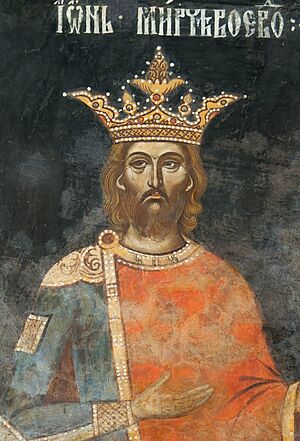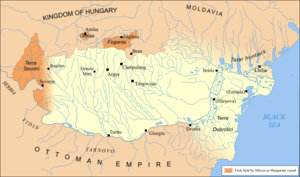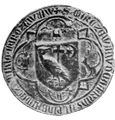Mircea the Elder facts for kids
Quick facts for kids Mircea the Elder |
|
|---|---|
| Voivode of Wallachia Despot of Dobruja |
|

Mircea the Elder. Fresco in the Episcopal Church of Curtea de Argeș
|
|
| Voivode of Wallachia (1st reign) |
|
| Reign | 23 September 1386 – November 1394 |
| Predecessor | Dan I of Wallachia |
| Successor | Vlad I of Wallachia |
| Voivode of Wallachia (2nd reign) |
|
| Reign | January 1397 – 31 January 1418 |
| Predecessor | Vlad I of Wallachia |
| Successor | Michael I of Wallachia |
| Born | c. 1355 |
| Died | 31 January 1418 (aged 62–63) |
| Burial | 4 February 1418 Cozia Monastery, Vâlcea County |
| Spouse | Doamna Mara Doamna Anca |
| Issue | Michael I of Wallachia Radu II Praznaglava Alexandru I Aldea Vlad II Dracul Ana of Wallachia Arina of Wallachia |
| House | Basarab |
| Father | Radu I of Wallachia |
| Mother | Doamna Calinichia |
| Religion | Orthodox Christian |
Mircea the Elder (Romanian: Mircea cel Bătrân; c. 1355 – 31 January 1418) was a very important ruler of Wallachia. He was the Voivode, or prince, of Wallachia from 1386 until he passed away in 1418. He was the son of Radu I of Wallachia and became ruler after his brother, Dan I of Wallachia, died.
During Mircea's time, Wallachia grew stronger. It developed its economy, government, and army. However, it also faced challenges from powerful neighbors. The Kingdom of Hungary and Poland wanted to control the Danube river area. The Ottoman Empire was also expanding in the Balkans.
Mircea the Elder ruled over the largest area Wallachia ever had. He gained control of Dobruja in 1388 and the Banate of Severin around the same time. He also held lands in Transylvania, like Amlaș and Făgăraș.
People called him "the Elder" after his death. This was to tell him apart from his grandson, Mircea II, who was called "the Younger." Many historians see him as the most important Wallachian ruler of the Middle Ages. Some even call him "Mircea the Great."
Mircea's Family and Descendants
Mircea was part of the House of Basarab, a powerful ruling family. His father was Radu I of Wallachia, and his mother was Doamna Calinichia.
He had several sons who also became rulers of Wallachia:
- Michael I of Wallachia
- Radu II of Wallachia
- Alexander I Aldea
- Vlad II Dracul
Mircea was also the grandfather of famous rulers like Mircea II and Vlad Țepeș (Dracula). Vlad Țepeș is known as the inspiration for the novel Dracula. Both Mircea II and Vlad Țepeș were skilled military leaders.
Mircea's Reign: A Time of Strength
Mircea's rule brought a lot of stability to Wallachia. Even though the region was often unstable, Wallachia reached its largest size under him. Its borders stretched from the Southern Carpathians in the north to the Black Sea in the east.
Mircea's official titles showed the lands he controlled. He was called "the great ruler and lord" of Wallachia. He was also the "duke of the Tartar parts" and ruler of lands like Amlaș, Făgăraș, and the Banat of Severin. He even ruled lands "even to the great sea" and the fortress of Dârstor.
Building Up Wallachia
Mircea worked hard to make Wallachia strong. He improved the government and helped the economy grow. He increased the money the state collected. He also minted silver coins that were used widely, even in other countries.
He gave special trading rights to merchants from Poland and Lithuania. This helped Wallachia's trade. With more money, Mircea could make his army stronger. He built up forts along the Danube river. He also made the "great army" bigger, which included townspeople and farmers. Mircea was also a strong supporter of the Eastern Orthodox Church.
Forming Important Alliances
Mircea understood the importance of friends in a dangerous world. He created strong alliances to protect Wallachia's independence.
- He made a treaty with Władysław II Jagiełło, the king of Poland, in 1389. This treaty was renewed several times.
- He also had good relations with Sigismund of Luxembourg, the king of Hungary. They both wanted to stop the Ottoman Empire from expanding.
Battles Against the Ottoman Empire

Mircea often helped the Bulgarians who were fighting the Turks. This led to conflicts with the powerful Ottoman Empire.
In 1394, Sultan Bayezid I crossed the Danube with a huge army of 40,000 men. Mircea had only about 10,000 soldiers. He knew he couldn't win a direct fight. So, he chose to fight a "guerrilla war." This meant he would avoid big battles. Instead, he would use small, quick attacks and retreats. He also tried to cut off the enemy's food supplies.
On October 10, 1394, the armies finally met at the Battle of Rovine. The battle took place in a forested and swampy area. This made it hard for the Ottomans to use their large army effectively. Mircea won this fierce battle and forced the Ottomans out of Wallachia. This famous battle was later written about by the poet Mihai Eminescu. However, after the battle, Mircea had to go to Hungary for a short time. The Turks put another ruler, Vlad Uzurpatorul, on the throne of Wallachia.
Continuing the Fight
In 1396, Mircea joined a large Christian army in a crusade against the Ottomans. This crusade ended with a big Ottoman victory at the Battle of Nicopolis.
The next year, in 1397, Mircea returned to Wallachia. With help from the Voivode of Transylvania, Stibor, he defeated Vlad the Usurper. He then stopped another Ottoman attack that crossed the Danube. In 1400, he defeated yet another Ottoman army.
A big event happened in 1402: Sultan Beyazid I was defeated by Timur Lenk (Tamerlane) at Ankara. This caused a period of chaos in the Ottoman Empire. Mircea used this chance to his advantage. He worked with the Hungarian king to launch a campaign against the Turks. In 1404, Mircea was able to take back control of Dobruja. He even got involved in the struggles for the Ottoman throne, helping one prince, Musa, become sultan for a short time. This was when Mircea was at the peak of his power.
Towards the end of his rule, Mircea signed a peace treaty with the Ottomans. He agreed to pay them 3,000 gold pieces each year. In return, the Ottomans promised not to turn Wallachia into one of their provinces. This helped Wallachia stay independent.
Mircea's Lasting Impact

Mircea the Elder ruled Wallachia for 32 years. A German historian called him "the bravest and ablest of the Christian princes."
He was also a "ktetor," meaning he founded and built churches and monasteries. One of his most famous buildings is the Cozia Monastery, built around 1390. He had churches built in styles similar to those in Serbia.
Mircea's reign is remembered as a time when Wallachia was strong and independent. He protected his country from powerful empires and left a lasting legacy.
Images for kids
|
Mircea the Elder
House of Basarab
Born: 1355 Died: 1418 |
||
| Regnal titles | ||
|---|---|---|
| Preceded by Dan I |
Voivode of Wallachia 1386–1394/1395 |
Succeeded by Vlad I Uzurpatorul (The Usurper) |
| Preceded by Vlad I Uzurpatorul |
restored as Voivode of Wallachia 1397–1418 |
Succeeded by Mihail I |






